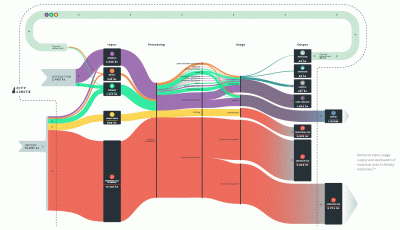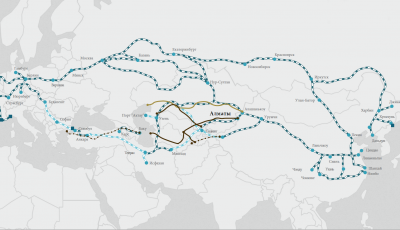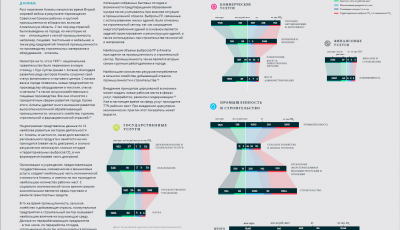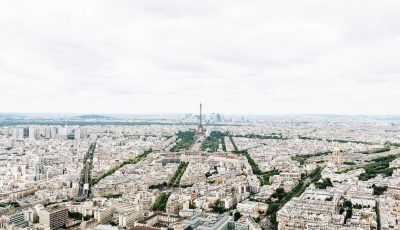8 July 2019. The city of Almaty in Kazakhstan is the first city outside of Europe which completed a detailed metabolic analysis to identify circular economy opportunities. In a metabolic analysis all resource flows are mapped out, tracing materials from their origin to their usage and eventual destination. Mapping out urban resource flows reveals how a city uses its resources to satisfy the needs of its citizens for shelter, nutrition and mobility. This blog tells you what we’ve learned from the start of this initiative 8 months ago.
1. In the transition to a circular economy, nobody starts from scratch

To understand the story behind the data and which circular economy opportunities are realistic, we mapped out already existing circular economy initiatives in Almaty. The report describes 40 circular initiatives, ranging from small start-ups to large government programmes. The overview of inspiring initiatives which are were already ongoing in Almaty, shows that the circular economy is not new to the city, and that there already is a solid basis to work from.
2. Focus on key processes, rather than sectors

Initially we planned to rank the sectors on their resource use and waste production and focus the analysis on the top three. We soon realised that this sector-approach would divert attention away from promising cross-sectoral solutions. Therefore, we decided to look at all sectors and focus on the three most impactful activities instead: production, consumption and construction.
3. Connect with the immediate challenges of the city
The urban planning bureaus of Almaty lacked an informed environmental perspective in their planning and design activities. The circular economy analysis filled that gap.

The environment is a public concern in Almaty. A survey by the municipality showed that citizens are concerned about air pollution from traffic and its health implications. Other topics in the political debate are the loss of architectural heritage due to modernisation and demolition of buildings, rising real estate prices and the risk that newly built urban areas become ‘sleeping districts’.
Urban planning and architecture are important tools to address these concerns. Therefore, we decided to add a spatial angle to the circular economy study. Like a product, also the design of a city determines to a large extent whether material and product cycles can easily be closed. This is about easy access to repair services, public transport, recycling stations or warehouses where construction companies can temporarily store secondary construction materials until they can be applied in a new building. It is also about whether there are public spaces where people can meet and deploy new circular concepts like landsharing. Artist impressions of urban districts show the circular economy can help maintain a degree of activity and vibrance at street level.
4. Visuals are crucial to be able to oversee the immense amount of data

The national and municipal statistics bureaus, NGO’s and waste management companies provided us with a wealth of data on extraction, production, consumption, import, export and the disposal of products and materials. Some of the databases had over 40,000 entries, all in Russian. Grasping the story behind that data is important to really understand the origin, purpose and destiny of resource flows in the city. For that we visualised the data, allowing us to involve experts and the general public in an informed dialogue on circular economy opportunities. Visual designers from Circle Economy and Fabrications were crucial in the visualisation process and the Center for Sustainable Production and Consumption in Almaty facilitated the broad dialogue with over 100 experts.
5. Language matters

Some of the circular economy jargon can not easily be translated into Russian. ‘Remanufacturing’ lacks a clear Russian equivalent and even circular economy as a term itself is still translated in different ways. In Russian language, some refer to it as a ‘closed loop economy’ (экономика замкнутого цикла), avoiding the word ‘circular’ (циркулярная) which people tend to associate with ‘circular saw’. In the case of ‘remanufacturing’ we decided to describe it. In the case of ‘circular economy’ we felt it would be good to introduce the term as a literate translation into Russian, to spread the term also in the Russian speaking parts of the world.
6. Look beyond the city boundaries and consider upstream impacts

A city is a centre of gravity for a large amount of goods and materials which are produced elsewhere. To be able to oversee the full climate impact of the city of Almaty, we also quantified upstream emissions. Examples are the emissions from cement kilns near Shymkent, or the emissions from blast furnaces in Temirtau, whose products also find their way to the construction sector in Almaty. Quantifying upstream emissions is also important from a political viewpoint, since upstream or consumption-based emissions are still poorly recognised, let alone addressed, under the Paris Agreement (Stanley Foundation, 2018; blog, 2017).

When taking a cross-sectoral, systemic perspective, we had to look beyond the boundaries of the city, sectors and the individual companies. By broadening our geographical scope we could include a wider range of circular economy solutions, and developments like the Belt and Road Initiative. Including the larger Almaty agglomerate allowed us to cover nearby existing and planned industrial areas. For agriculture we expanded the geographical scope to the whole province of Almaty, so that we could tap into the available organic residues from agricultural production.
7. Crisp, colourful design helps get the message across

At the World Circular Economy Forum in Helsinki, we distributed the first hardcopies printed on a rare combination of recycled paper from FSC certified sources. Everybody we approached took a copy home. That can only be a compliment to the skilled and dedicated designers which made the visuals and overall report design. The Russian hardcopy will be distributed in Almaty and Kazakhstan early August 2019.
Download the Circular Almaty report in English.
Download the Circular Almaty report in Russian (Скачать доклад на русском языке).
Funder: Emerging Markets Sustainability Dialogue Challenge Fund
Partners: Circle Economy; Center for Sustainable Production and Consumption in Almaty; Fabrications
Shifting Paradigms, July 2019



